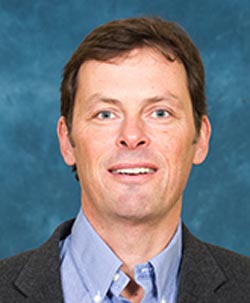Affiliation: Kelsey Museum of Archaeology

Dr. Geoff Emberling is an Associate Research Scientist working at the Kelsey Museum of Archaeology, University of Michigan. He holds his degrees from the University of Michigan (Ph.D.) and Harvard University, and his research interests include the ancient Middle East (Mesopotamia) and ancient North Africa (Nubia and Kush), particularly early states, cities, and empires, ethnicity and identity, heritage, and collaborative community archaeology. Since 2012 he has co-directed archaeological projects at El-Kurru and Jebel Barkal in northern Sudan. Dr. Emberling has recently co-edited The Oxford Handbook of Ancient Nubia (with B.B. Williams, 2021, Oxford University Press). His current publication projects include publication of his excavations in Sudan along with Excavations at Tell Brak, vol. 6: Institutions, Households, and Collapse in the Heart of Nagar, 2600-2000 BCE (co-edited with H. McDonald, in preparation). He is one of the AIA Joukowsky Lecturers for the 2024/2025 National Lecture Program season.
Archaeology is among the most colonial fields of research, with its roots in extractive relationships that aimed to bring objects from colonized communities back to the museums of Europe and the United States. Many archaeologists are now trying to find ways to rethink archaeological practice so that the benefits of our fieldwork extend to local colleagues and communities where we work.
El-Kurru is known in archaeology as the site of a royal pyramid cemetery of ancient Kush, but it is also a village of perhaps 3,000 people, mostly belonging to the Shaigiya tribe, who have their own perspectives on heritage. This talk describes the move from traditional archaeological research to a more collaborative model in the community of El-Kurru in northern Sudan.
Ancient Kush was one of the earliest and longest-lived empires in Africa, rivalled only by Egypt. We think of Kush in terms of its relationship to Egypt of the pharaohs, but in fact Kush remained in power long after the last Egyptian pharaoh, and indeed was a rival and trade partner of ancient Rome after the Roman conquest of Egypt in 31 BCE.
The initial contact with Rome resulted in a series of skirmishes in which the Kushite army was led in battle by a ruling queen or kandaka, who one Roman source described as “a masculine sort of woman who was blind in one eye”. The kandakas were part of a long line of powerful Kushite royal women, and they remain important symbols even in Muslim Sudan today.
This talk describes the long relationship between Kush and the Roman world, including espionage, conflict, and a long a rich trade and gift exchange.
Archaeology in the Nile Valley has a long tradition of focusing on excavation of tombs and monumental buildings, both in Egypt and in Sudan, home to the ancient empire of Kush. Cities and smaller settlement sites have been neglected until recently, giving us an inadequate understanding of these ancient cultures.
The Jebel Barkal Archaeological Project has worked at one of the capital cities of ancient Kush since 2016. In this lecture, the co-director of the project discusses research at Jebel Barkal (ancient Napata) that has provided us a glimpse of the city plan, an understanding of its place in a changing local environment and climate, and a first glimpse of the diet of the inhabitants of the city. The results provide surprising insights into the cultural and economic connections between the city and the rest of ancient Kush.
Ancient Napata (modern-day Jebel Barkal) has long been known as one of the capital cities of the empire of Kush. Located on the Nile River in what is now northern Sudan, it rose to prominence when the kings of Kush conquered Egypt, where they would rule as its 25th Dynasty (ca. 715-653 BCE).
The site’s pyramids, temples, and palaces have attracted the attention of archaeologists for more than a century. A new archaeological project at the site aims to connect these scattered monuments as elements of an ancient city.
Our first step has been to locate the settlement itself—where did people live? This talk will outline our first steps in identifying this “lost city” of ancient Kush.
An important component of our work at the site has been developing a fully collaborative project with our Sudanese colleagues, and talking with the local community to begin to understand the range of their engagement with the site. This talk can also address what it means to conduct a “post-colonial” archaeological project.
See Geoff Emberling's work in the American Journal of Archaeology.
Notifications